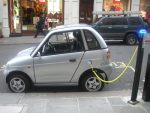
The largest clean energy investment the U.S. has made, the Inflation Reduction Act, IRA, is now a year old. President Joe Biden was recently in New Mexico touting the benefits of the IRA. As 350 New Mexico says on its website, “The IRA offers consumers, companies and contractors a once in a generation opportunity to go electric at a substantial discount.”
This is a very big deal since most of our emissions come from cars and home heating. So how will this act help you? Check out 350newmexico.org/electrify-new–mexico and Rewiring America. Download Rewiring America’s guide: www.rewiringamerica.org/IRAguide. It tells you everything you need to know. They call the IRA a free electric bank account with your name on it. That means the government will pay for the decarbonization of your home, allowing you to replace old fossil-fueled appliances like your furnace, water heater, kitchen stove and dryer for new and clean electric ones. Do it gradually over ten years, or more rapidly, if that works for you. They pay, and you, your children, and the environment gain.
The average household will save about $1,800 a year by going electric. The air in your home will be cleaner. And it is empowering. It is one of the most important things we can do as individuals to fight the climate crisis and help build a resilient climate–safe future.
There are two parts. The new rebates are discounts that apply at purchase and would allow you to get free or reduced prices on things like a new electric stove. The other part of the program is tax credits. If you buy an electric car after 2024 you can get up to $7,500 off the sticker price right at purchase, if your taxes in the year of purchase will equal or exceed $7,500.
It sounds like a no-brainer. But you have to qualify. Most low income and moderate-income homeowners will qualify for rebates, as will renters. Wiring America has an IRA calculator on their website that will tell you exactly how much will be in your IRA “savings account.” You just put in your family income, number of family members who live with you and the city you live in. For example, let’s say you have a family income of $50,000, have 4 family members and you live in Albuquerque. Bingo! Your energy account will be $14,000. If your family income is $150,000 you don’t qualify for rebates, but you do get up to $17,000 in tax credits.
Tax credits work differently than rebates. You have to pay taxes to use them. And the more expensive EVs do not qualify.
Here is what you can expect from the rebate portion of the IRA. You can get up to $8,000 for heat pumps, $4,000 to have your electrical panel upgraded, $1,750 for a heat pump hot water heater, $2,500 for new wiring, $1,600 for home insulation, $840 for a new electric stove — to a total of $14,000 based on income. This is in addition to the tax credits of 30% for heat pumps, water heaters and electrical upgrades, and solar installations, up to $4,000 for a used electric car and $7,500 for a new one.
There are also special programs for renters. No one will be left out of this program. Even wealthy people who do not qualify for rebates can still use the tax credits.
We all need to electrify and we need to do it soon. The tax credits are available now, but the rebates are not. In July the federal government — DOE — issued guidelines to the states on how the rebate will work. Each state has to set up its own programs. It will still be a while before you can cash in on your electric bank account.
Sidney Hill is the public information officer for the New Mexico Minerals and Natural Resources Department. NMRD is developing our state’s rebate program. He told me “they expect rebates under the Home Energy Rebate Program to be available to consumers in late 2024 or early 2025.” He added that, “they are working hard on their application to DOE and hope for early approval.”
But it is not too early to plan. Spend some time on Rewriting America’s website. Determine what you qualify for and make your plan. What would you do first? What can wait? Study the examples of how others are planning to fully use the credits and rebates. Get ready, Get set, Go Electric!
Published on September 18, 2023, in the Albuquerque Journal.
© Judith Polich. All Rights Reserved. May be republished with author’s written consent and proper attribution.
